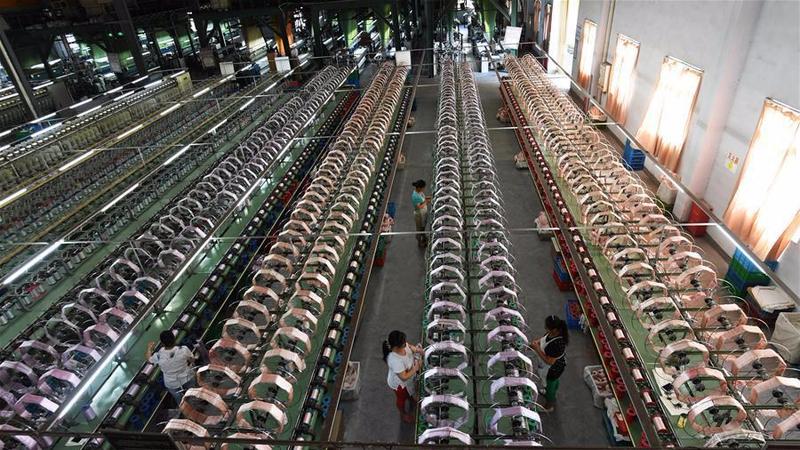
Bloomberg reports that Chinese industrial profits maintained their recent surge, underscoring resilience in the economy and strength in producer inflation. Industrial profits increased 25.1 percent in October from a year earlier, compared with a 27.7 percent pace a month earlier that was the highest in almost six years, the National Bureau of Statistics said Monday. Profits in the first 10 months of the year climbed 23.3 percent to 6.25 trillion yuan ($946 billion)."Industrial profits in China remain strong, supported by the significant easing in Chinese monetary conditions in 2016," said Callum Henderson, a managing director for Asia-Pacific at Eurasia Group in Singapore. "Going forward, however, with monetary conditions tightening somewhat this year given a stronger currency and higher market interest rates, we expect both real gross domestic product growth and corporate profits.Robust factory inflation has kept mills and plants profitable most of this year, and the authorities' moves to clean up pollution has benefited stronger firms as smaller competitors shut down. That boom will be tested by a cooling property market and intensified actions to reduce leverage as the country's leadership de-emphasizes nominal growth targets.
Bruce Jones of the Brookings Institution writes that China has reached a point of economic and political confidence where it no longer looks to the West for advice, and is gaining confidence in charting its own path in both domestic and international affairs. And it is increasingly assertive in its relationships with its neighbors in Asia. China is hardly the first rising power to seek primacy in a contested neighborhood. The experiences of late 19th century Germany and Japan may offer insights into the questions, decisions, and domestic political challenges China's leadership will face as they continue their rise. Ongoing U.S. debate over the future of U.S.-China relations turns on the question of whether, how, and at what cost the United States should seek to prevent China from establishing regional military hegemony in the Asia-Pacific. All sides in this debate seek to avoid direct conflict between the United States and China, but disagree as to how to achieve this goal, and what the threshold for military confrontation should be. Nevertheless, across various schools of thought there is growing support for a more assertive U.S. response to Chinese actions that disadvantage the United States economically or challenge the credibility of U.S. security commitments to allies and partners. There is often a false dichotomy between competition versus cooperation in U.S.-China relations. In fact, there are—and should be—elements of both competition and cooperation in both the economic and security spheres. The greatest risk of conflict between the United States and China stems from the tension between America's naval presence in Asia coupled with U.S. alliance commitments, and China's effort to push the United States out of the East and South China Seas. However, the most acute crisis in the region is North Korea, where Chinese and American interests, while not aligned, at least overlap, leaving some prospect for growing cooperation.
- 2017-11-24 A Chinese Kindergarten Is Being Investigated for Sexually Abusing and Drugging Children
- 2017-11-22 U.S. Sanctions 13 Chinese and North Korean Organizations
- 2017-11-21 China and the United States Are Equals. Now What?
- 2017-11-20 U.S. Rebuffs China’s Charm Offensive, Edging Closer to Trade War
- 2017-11-19 Beyond Trump-Xi Bond, White House Looks to Toughen China Policy
- 2017-11-17 Is it time for U.S. concessions to defuse North Korea crisis? China says yes.
- 2017-11-16 Why the West Should Take China's Belt and Road Initiative Seriously
- 2017-11-15 China Will Send Envoy to North Korea, Likely to Urge Nuclear Talks
- 2017-11-14 Susan Rice: Trump Is Making China Great Again
- 2017-11-13 Trump has a long way to go on the road to fixing US-China trade
- Reuters Beijing kindergartens get permanent inspectors after abuse scandal: Xinhua
- Forbes Inside The Next Moves Of Tencent, The First-Ever $500B Tech Company
- Financial Times Canada's Trudeau to visit China in December
- CNBC This huge Arab sovereign wealth fund is making a big bet on China with firms like Didi Chuxing
- The Washington Post Chinese premier in Hungary for regional summit
- Reuters Hungary launches rail link tender as CEE-China summit starts
- CNBC Nepal state firm to build $2.5 billion power project after China deal scrapped
- Wall Street Journal Blast Kills Two, Wrecks Buildings at Busy Chinese Port City
- Reuters Stephen Hawking lauds Chinese pop star for space migration question
- Reuters China's RYB Education fires head of Beijing kindergarten embroiled in abuse scandal
- Financial Times Debt increase drives China's asset management reforms
- Financial Times Beijing steps up evictions in gentrification push
- New York Times A Defiant Map-Hunter Stakes Vietnam's Claims in the South China Sea
